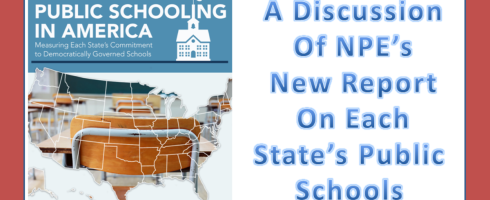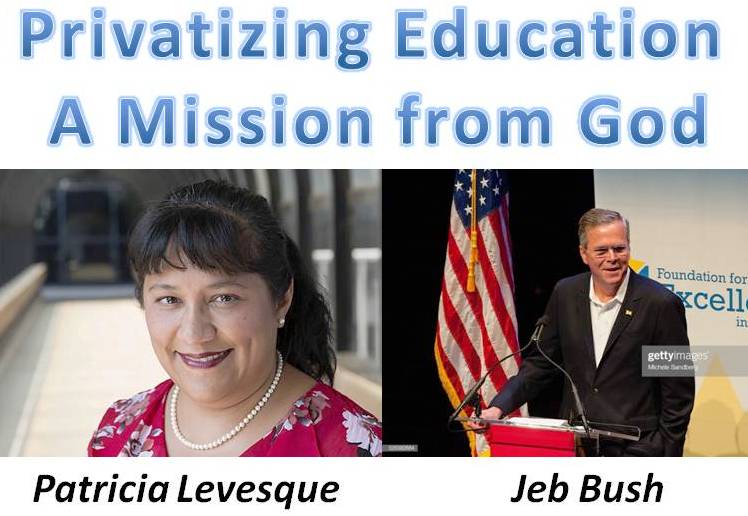By Thomas Ultican 3/7/2024
A new report from Network for Public Education (NPE) concludes, “The war on public education has always been a part of Christian nationalism” (Page 32). NPE graded America’s schools using a 111 point scale: a) Voucher and Charter Expansion and Protections – 66 points, b) Homeschooling governance – 7 points, c) Financial Support for Public Schools – 14 points and d) Freedom to Teach and Learn – 24 points (Page 9). The results from these category totals indicate, among other things, the extent of radical Christian and billionaire libertarian influence in each state.
No state earned a perfect 111 points with North Dakota’s 98 points being the high score. NPE translated the scores into letter grades of A – F: A – 86 to 98, B – 78 to 85, C – 67 to 77, D – 55 to 66 and F – 54 and below (Page 10). The top five states, all with A’s, and bottom five states, all with F’s, are listed below (Page 11).
Top and Bottom Five
| A Grades | Score | F Grades | Score | |
| North Dakota | 98 | Arkansas | 37.5 | |
| Connecticut | 93 | North Carolina | 32 | |
| Vermont | 90.5 | Utah | 29.5 | |
| Illinois | 89 | Arizona | 22.5 | |
| Nebraska | 87 | Florida | 19 |
Interesting Privatization Observations
Stunningly, voucher costs have grown exponentially since 2000 while private school enrollment shrunk, decreasing from 11.38% in 1999 to 9.97% in 2021 (Page 5). The only way this could happen is if the public started paying for students who were already in private schools.
Of the 240 new charter schools in the US from 2022-2023, thirty of them had 25 or fewer students. A comparison of the National Center for Education Statistics data between 2021 and 2022 revealed 139 charter schools closed (Page 5).
NPE reported:
“Neighborhood public schools remain the first choice of the overwhelming majority of American families. Despite their popularity, schools, which are embedded in communities and governed by elected neighbors, have been the target of an unrelenting attack from the extreme right” (Page 4).
The title for most privatized school system in the US belongs to Florida. Even there, with its 74% public school enrollment, the popularity is unchallenged (Page 6).
Public schools enroll about 90% of America’s K-12 students.
A Pennsylvania investigation discovered that 100% of voucher schools examined, engaged in some form of discrimination. The schools’ decisions were based on LGBTQ status, disability, academic capacity, family religion and “even pregnancy”. Dayspring Christian Academy declared that supporting the rights of LGBTQ students was also a reason for being denied enrollment or expulsion (Page 12).
The District of Columbia and 30 states have voucher programs with many having multiple programs. Some states allow participants to be in more than one program. Middle class and wealthy families who never had children in public schools now have tax-dollar generated sources flowing toward them (Page 12).
We now have the ludicrous situation where poor people are supporting private school students from wealthy families.
Root of Christian Nationalism
Carol Burris and her team at NPE observed:
“The war on public education has always been a part of Christian nationalism. As that movement rises, so do the attacks on public schools. Randall Balmer of Dartmouth College argues in his piece in Politico that the origins of the political power of the Religious Right began not with Roe v. Wade but rather with Green v. Kennedy, which denied segregation academies tax-exempt status. According to Balmer, that decision gave religious conservative Paul Weyrich an opening to leverage Evangelical political power. Today, the Heritage Foundation, the organization he co-founded, is part of a billionaire-funded effort to destroy ‘government schools’ under the banner of school choice.” (Page 32)
In 1973, Paul Weyrich co-founded the Christian nationalist think-tank, The Heritage Foundation, which has been brutal to the America I love. They attacked the separation of church and state guaranteed in the 1st amendment to the US constitution, undermined democratic action and demanded fidelity to their ideals. In their world, it is forbidden to embrace humanistic principles, share resource or help non-Christians.
Katherine Stewart discussed Weyrich in her book, The Power Worshippers. After the Democratic Party’s embrace of civil rights, Richard Nixon’s “Southern strategy” became a winner. Stewart shared, “If the right could access the religious vote, Weyrich reasoned, power would be in its grasp” (Worshippers 60).
In historian, Randall Balmer’s book, Thy Kingdom Come: How the Religious Right Distorts the Faith and Threatens America, Weyrich claimed that it was the 1975 IRS action against Bob Jones University that caused the Religious Right’s rise, not abortion. Only after New Right leaders held a 1978 conference call to discuss strategy, was abortion was put on their political agenda (Worshippers 64).
With the Soviet Union’s fall, Weyrich saw an opportunity to unite with religious conservatives in Russia and Eastern Europe. Stewart noted:
“All told, Weyrich made more than a dozen trips to Russia and Eastern Europe in the aftermath of the fall of communism. At the time of his death in 2008, even as he was riding high on a wave of plutocratic money in the United States, he was writing and speaking frequently in defense of Russia and facilitating visits between U. S. conservatives and Russian political leaders.” (Worshippers 270)
The long relationship between Christian nationalists and Russian plutocrats informs us why some Republicans support Russia against Ukraine. A pro-Russian attitude goes along with opposing public education. To Christian nationalists, the enemy is secular humanism and public schools reek of it.
Weyrich spent the last decade of his life in excruciating pain. In 1996, he fell on black ice, suffering a spinal injury. By 2001 he required a wheel chair to get around and in 2005; both his legs were amputated from his knees down. He was in constant pain until his death in late 2008.
Why was Florida Last
The team at NPE has provided a fair and well researched assessment of public schools across America. Their four categories and weightings they used to compare schools from many jurisdictions are reasonable. Clearly privatization efforts do significant harm to public education; making giving them 51% of the grade acceptable. Assigning 22% of the grade to protect freedom to teach may be a little low but OK. School finance, getting 13% of the grade, is definitely not too much and 6% of the grade, coming for homeschooling protection, is a needed new category.
With homeschooling accelerating over the last two decades, the need to protect children educated at home has become more critical. The Coalition for Responsible Home Education was founded by adults, who were themselves homeschooled. Their database contains documented stories of brutal neglect, including homeschooled children murdered, sexually assaulted, imprisoned, and starved. Unfortunately these stories almost never garner national attention. Students in brick and mortar schools also suffer this kind of abuse but they are around mandated reporters (teachers) every day and are not hidden from sight like homeschooled kids.
Using well-sourced data and a four-category rubric, NPE has provided parents throughout the United States with tools to evaluate their states education leadership.
NPE mentioned The Heritage Foundation and its connection to Christian nationalism, which is leading the war against public education. Before he was elected governor of Florida, Jeb Bush served on the Heritage board. It was there he developed his agenda for privatizing public education. His most influential adviser was Patricia Levesque, a graduate of Bob Jones University, the fundamentalist Christian school in South Carolina.
Little wonder that Florida was dead last in supporting public education in America.






















